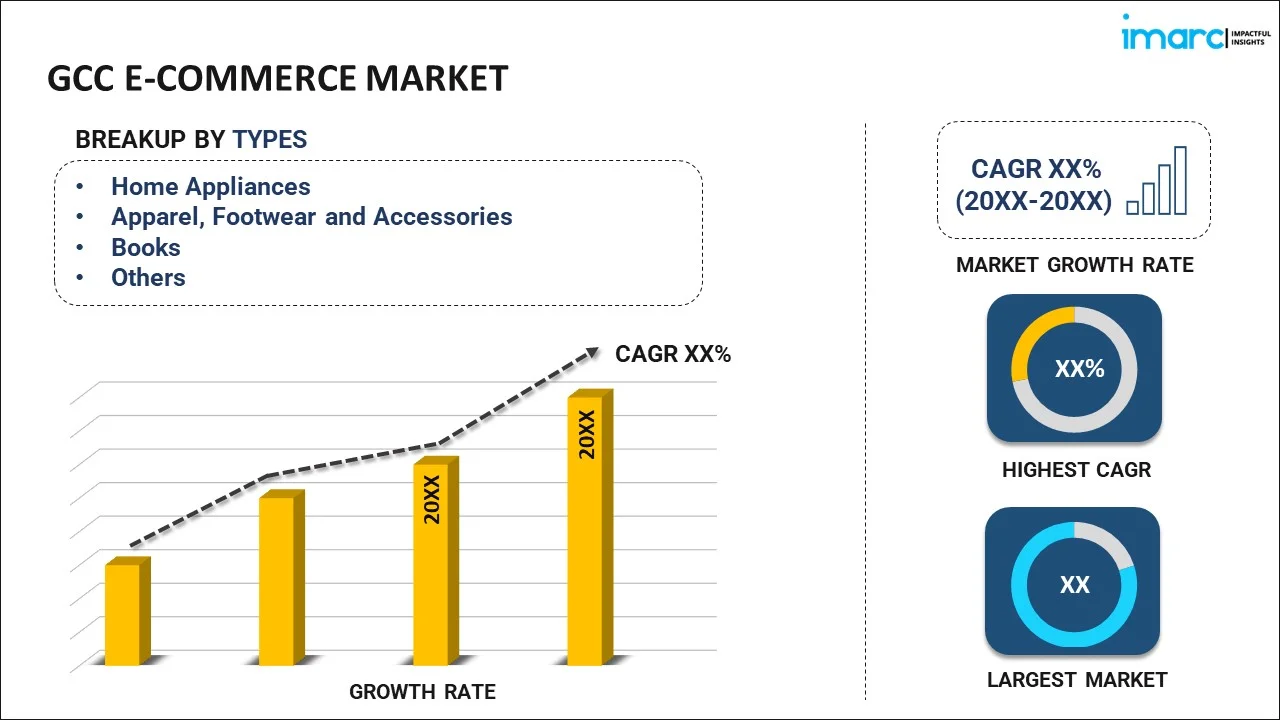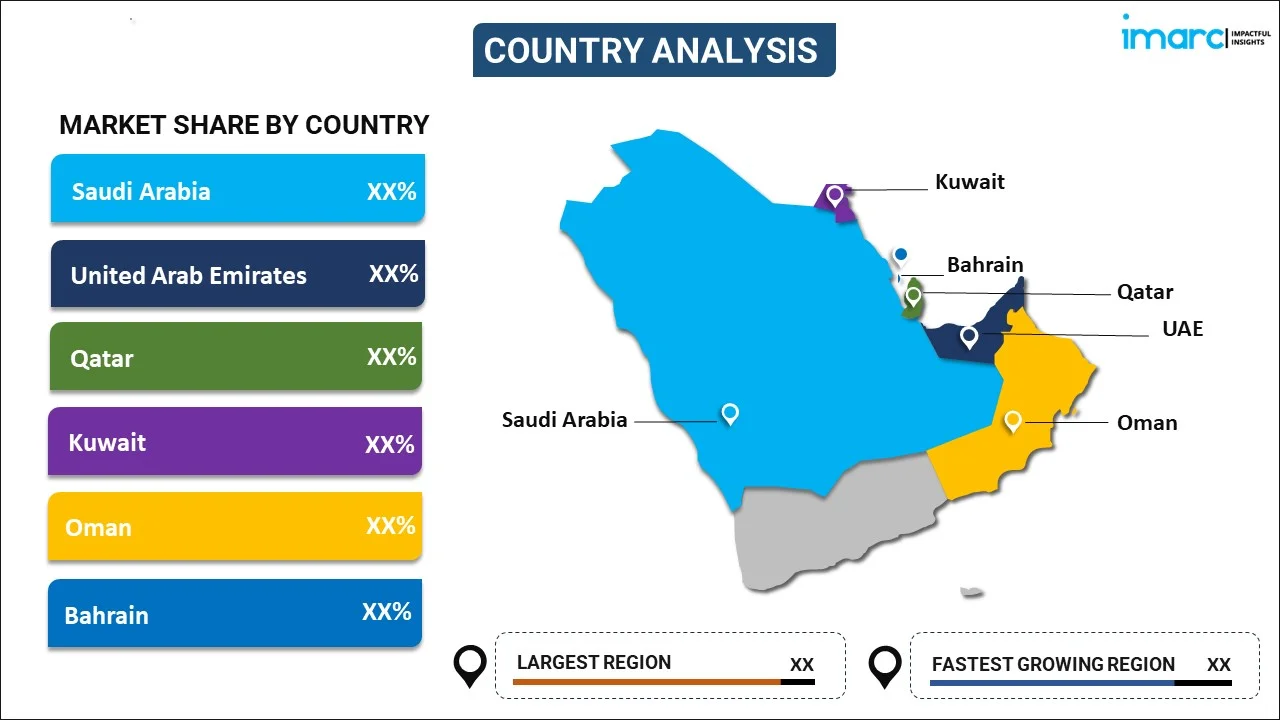
GCC E-Commerce Market Report by Type (Home Appliances, Apparel, Footwear and Accessories, Books, Cosmetics, Groceries, and Others), Transaction (Business-to-Consumer, Business-to-Business, Consumer-to-Consumer, and Others), and Country 2026-2034
Market Overview:
The GCC e-commerce market size reached USD 584.8 Billion in 2025. Looking forward, IMARC Group expects the market to reach USD 2,081.1 Billion by 2034, exhibiting a growth rate (CAGR) of 15.15% during 2026-2034. The rapid digitalization, growing consumer confidence with online transactions, expanding young and tech savvy population base, rising urbanization and changing lifestyles, economic diversification and favorable government initiatives and support represent some of the key factors driving the market.
|
Report Attribute
|
Key Statistics
|
|---|---|
|
Base Year
|
2025
|
|
Forecast Years
|
2026-2034
|
|
Historical Years
|
2020-2025
|
|
Market Size in 2025
|
USD 584.8 Billion |
|
Market Forecast in 2034
|
USD 2,081.1 Billion |
| Market Growth Rate 2026-2034 | 15.15% |
Access the full market insights report Request Sample
E-commerce, short for electronic commerce, refers to the buying and selling of goods and services over the internet. It has become a pivotal aspect of modern business operations, reshaping the global marketplace. E-commerce is marked by its distinct characteristics that set it apart from traditional commerce. Characteristics of e-commerce include its borderless nature, enabling businesses to reach a global customer base without geographical constraints. It offers convenience and accessibility, allowing consumers to shop anytime and anywhere, fostering a seamless shopping experience. Another feature is the elimination of intermediaries, as transactions often occur directly between the buyer and seller, reducing costs and enhancing efficiency. Additionally, e-commerce facilitates personalized shopping through data-driven recommendations, enhancing customer engagement and satisfaction. Key features of e-commerce platforms encompass secure payment gateways, ensuring the confidentiality of financial information and safeguarding against fraudulent activities. Product catalogs and detailed descriptions aid customers in making informed decisions, replicating the in-store shopping experience. Efficient order tracking and delivery notifications bolster customer trust and loyalty. Furthermore, e-commerce platforms often incorporate reviews and ratings, fostering transparency and helping consumers make well-founded choices. E-commerce's significance is underscored by its potential to connect businesses with a global audience, streamline operations, and provide a convenient shopping avenue for consumers.
GCC E-Commerce Market Trends:
The rising demand for modern digital commerce solutions represents one of the key factors driving the growth of the GCC e-commerce market. Additionally, the widespread adoption of e-commerce across diverse sectors, including retail, hospitality, and finance, is amplifying its relevance, thereby driving substantial market expansion. Moreover, an increase in innovation and collaborative efforts between governmental bodies and technology enterprises is elevating the digital capabilities of e-commerce platforms, effectively bolstering market growth. Furthermore, the establishment of regulatory frameworks aligned with consumer protection and transaction security is nurturing market proliferation, ensuring reliable and secure online transactions. Alongside this, the emergence of localized e-commerce platforms, tailored to meet the specific demands of the region, is significantly energizing the market growth. Besides this, initiatives promoting digital transformation in industries such as logistics, payment systems, and customer engagement are fostering a positive market outlook. The rising trend towards contactless transactions, coupled with the strategic integration of e-commerce solutions within various sectors, is further accelerating market expansion. The decentralization of e-commerce operations, with a focus on regional customization and adaptation, is also contributing to sustained market growth. Other factors, such as diversified e-commerce offerings, substantial investments in technological innovation, and a steadfast commitment to meeting consumer preferences, are driving the growth of the GCC e-commerce market.
GCC E-Commerce Market Segmentation:
IMARC Group provides an analysis of the trends in each segment of the GCC e-commerce market report, along with forecasts at the country levels for 2026-2034. Our report has categorized the market based on type and transaction.
Type Insights:

To get detailed segment analysis of this market Request Sample
- Home Appliances
- Apparel, Footwear and Accessories
- Books
- Cosmetics
- Groceries
- Others
The report has provided a detailed breakup and analysis of the market based on the type. This includes home appliances, apparel, footwear and accessories, books, cosmetics, groceries, and others.
Transaction Insights:
- Business-to-Consumer
- Business-to-Business
- Consumer-to-Consumer
- Others
A detailed breakup and analysis of the market based on the transaction has also been provided in the report. This includes business-to-consumer, business-to-business, consumer-to-consumer, and others.
Country Insights:

To get detailed regional analysis of this market Request Sample
- Saudi Arabia
- UAE
- Qatar
- Bahrain
- Kuwait
- Oman
The report has also provided a comprehensive analysis of all the major regional markets, which include Saudi Arabia, the UAE, Qatar, Bahrain, Kuwait, and Oman.
Competitive Landscape:
The report has also provided a comprehensive analysis of the competitive landscape in the market. Competitive analysis such as market structure, key player positioning, top winning strategies, competitive dashboard, and company evaluation quadrant has been covered in the report. Also, detailed profiles of all major companies have been provided.
GCC E-Commerce Market Report Coverage:
| Report Features | Details |
|---|---|
| Base Year of the Analysis | 2025 |
| Historical Period | 2020-2025 |
| Forecast Period | 2026-2034 |
| Units | Billion USD |
| Scope of the Report | Exploration of Historical and Forecast Trends, Industry Catalysts and Challenges, Segment-Wise Historical and Predictive Market Assessment:
|
| Types Covered | Home Appliances, Apparel, Footwear and Accessories, Books, Cosmetics, Groceries, Others |
| Transactions Covered | Business-to-Consumer, Business-to-Business, Consumer-to-Consumer, Others |
| Countries Covered | Saudi Arabia, UAE, Qatar, Bahrain, Kuwait, Oman |
| Customization Scope | 10% Free Customization |
| Post-Sale Analyst Support | 10-12 Weeks |
| Delivery Format | PDF and Excel through Email (We can also provide the editable version of the report in PPT/Word format on special request) |
Key Questions Answered in This Report:
- How has the GCC e-commerce market performed so far and how will it perform in the coming years?
- What has been the impact of COVID-19 on the GCC e-commerce market?
- What is the breakup of the GCC e-commerce market on the basis of type?
- What is the breakup of the GCC e-commerce market on the basis of transaction?
- What are the various stages in the value chain of the GCC e-commerce market?
- What are the key driving factors and challenges in the GCC e-commerce market?
- What is the structure of the GCC e-commerce market and who are the key players?
- What is the degree of competition in the GCC e-commerce market?
Key Benefits for Stakeholders:
- IMARC’s report offers a comprehensive quantitative analysis of various market segments, historical and current market trends, market forecasts, and dynamics of the GCC e-commerce market from 2020-2034.
- The research study provides the latest information on the market drivers, challenges, and opportunities in the GCC e-commerce market.
- Porter's five forces analysis assist stakeholders in assessing the impact of new entrants, competitive rivalry, supplier power, buyer power, and the threat of substitution. It helps stakeholders to analyze the level of competition within the GCC e-commerce industry and its attractiveness.
- Competitive landscape allows stakeholders to understand their competitive environment and provides an insight into the current positions of key players in the market.
Need more help?
- Speak to our experienced analysts for insights on the current market scenarios.
- Include additional segments and countries to customize the report as per your requirement.
- Gain an unparalleled competitive advantage in your domain by understanding how to utilize the report and positively impacting your operations and revenue.
- For further assistance, please connect with our analysts.
 Request Customization
Request Customization
 Speak to an Analyst
Speak to an Analyst
 Request Brochure
Request Brochure
 Inquire Before Buying
Inquire Before Buying




.webp)




.webp)












